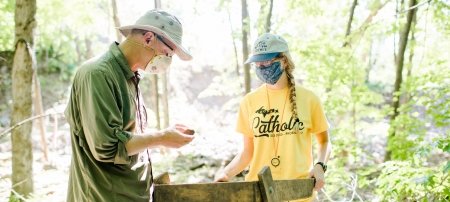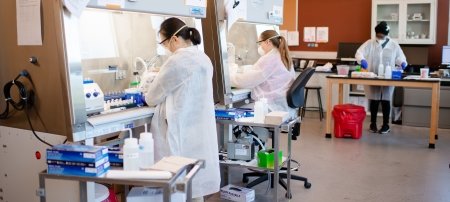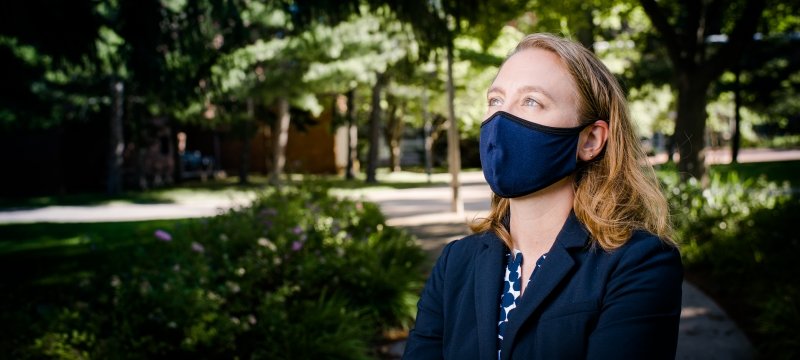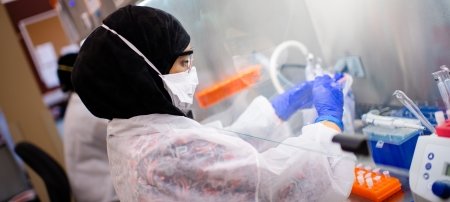Return-to-campus plans vary widely by school as COVID-19 cases continue to rise in the US. Researchers say Michigan Tech has one of the most robust plans in the nation.
Thousands of college students are returning to campuses across the country. But, just days after welcoming students back, or even prior to doing so, a number of universities have already transitioned back to remote instruction following clustered outbreaks of COVID-19.
In this context, researchers at Cal Tech and Johns Hopkins University combed through the return-to-campus plans of more than 500 US universities and found that these plans are widely different. The researchers found only 27% of universities (both public and private) are performing some sort of COVID-19 testing on their campuses; only 16% of public universities plan to test. And only 20% of universities have regular surveillance testing planned. According to the data compiled by the Cal Tech and Johns Hopkins researchers, just 53 schools will do both symptomatic and asymptomatic testing.
Tracking SARS-CoV-2 in Human Waste
When the virus that causes COVID-19 finds its way into wastewater, what happens to it? Read more on mtu.edu/news.
According to the Cal Tech database of university testing plans made available, Michigan Technological University is one of an even smaller handful of universities with a highly robust plan to bring students back to campus and to regularly test asymptomatic students, in addition to identifying and testing students who are symptomatic. While it is still possible for the virus to appear and spread on campus, Michigan Tech is positioned to act early, with on-campus baseline and surveillance testing for students, access to asymptomatic testing for staff, social distancing procedures, a central information repository, hybrid class delivery methods, campus wastewater testing and established partnerships with area health care providers.
“We have a comprehensive plan and we’re trying to cover all the bases, but nothing is 100% assured. We are prepared for eventualities,” said David Reed, vice president for research at Michigan Tech. “After we get the tests back from this past weekend, we’ll know pretty much where we’re at. If we’re at a very low positive rate, we’re in pretty good shape. If we’re at a higher positive rate, we have plans in place to respond quickly and appropriately.
“A lot of schools are doing testing initially and then only symptomatic testing after that, which won’t allow them to see how it changes prevalence in the population day to day and week to week, which we will be seeing.”
A Multifaceted Plan
Michigan Tech began operating its COVID-19 testing lab in April. The lab can process approximately 150 individual samples per day, or 500 pooled samples per day, with 98% of results coming back in 36 hours. Students began returning to campus Friday, Aug. 21, and all first-year students living in on-campus housing were asked to self-monitor for symptoms 14 days ahead of their arrival and to complete a baseline COVID-19 test once they arrived. The University will also conduct surveillance testing — in which a certain percentage of the student population is tested to get a sense of whether COVID-19 infections are increasing or decreasing.
About the Researcher
During baseline and surveillance testing, Michigan Tech student samples will be pooled in groups of five. The University's COVID-19 lab will take a portion from each of the five student samples, combine them to create a pool, and run one diagnostic test on the pool. If the pool tests positive, the five samples will be tested again individually.
“We know that if we get 15 cases, for example, they’ve been out in the community and we know there will be an increase in cases — a second generation of cases. If we can quarantine those contacts, we’ll stop the spread at that point,” said Kelly Kamm, an epidemiologist at Michigan Tech and expert in rural health. “Just looking at the case count doesn’t give you a good view of what’s going on. If we know a good chunk of our new cases were quarantined before they became cases, we can stop it.”
Working with its health insurance provider, Michigan Tech is also providing two free-of-charge asymptomatic tests to all University employees during the fall semester.
“We don’t have a university health system. We are at a major disadvantage to doing baseline and surveillance testing, and yet we have figured it out by working with our local community health providers,” Kamm said. “It says a lot that when it came through many insurance companies wouldn’t pay for asymptomatic testing, our administration said we’re still going to do testing and not charge the students.”
“Our contact tracers will also be paid, even as the state of Michigan contact tracing workforce is still volunteer,” she said.
Punching Above Its Weight
Of the 53 colleges and universities known to be conducting both asymptomatic and symptomatic student testing, many have large endowments, providing a reservoir from which to draw funding for testing. Michigan Tech’s endowment is approximately $115 million, or roughly $17,000 per full-time enrolled student (compared to schools that have close to $1 million or even more per full-time enrolled student). Though its endowment is smaller, Michigan Tech is committed to regular surveillance testing of its student body and asymptomatic testing of staff.
Disrupt, Concentrate, Extract, Quantify
Wastewater monitoring on campus is a crucial component of Michigan Tech's return-to-campus plan — people begin shedding the virus in feces before they become symptomatic.
Studies have shown that SARS-CoV-2 levels in wastewater predict the number of symptomatic individuals infected with COVID-19. Weekly monitoring of wastewater flows on campus should reveal trends in the number of infections on campus, even if infected individuals are asymptomatic. If SARS-CoV-2 levels increase in the wastewater stream generated by a particular residential building, University officials can intensify focus on that particular location to increase diagnostic testing of the asymptomatic residents of that building to limit the spread of the virus among their contacts.
Jennifer Becker, associate professor of civil and environmental engineering, said some of the sampling will occur at a location where the wastewater from several residence halls comes together into a single stream. The combined samples collected at this location will provide information similar to the pooled samples being analyzed by the clinical laboratory. If the combined sample is positive for SARS-CoV-2, wastewater flows from the individual residence halls will be evaluated. Specifically, the Michigan Tech researchers have proposed to monitor sanitary wastewater discharges from Wadsworth Hall, East and West McNair Halls, Douglass Houghton Hall, and Hillside Place, as well as the Student Development Complex recreation center.
About the Researcher
The process Becker uses to quantify the virus in wastewater has four main steps: disrupt the virus structure using chemical methods (including adding large amounts of sodium chloride to the sample), concentrate the viral genetic material (ribonucleic acid, or RNA), extract the virus RNA from the wastewater, and then quantify the amount of the viral RNA in the samples using a technology known as reverse transcription-quantitative polymerase chain reaction (RT-qPCR).
In RT-qPCR, the viral RNA in a sample is converted to deoxyribonucleic acid (DNA), which is tagged with a fluorescent dye. The fluorescent DNA is then copied in repetitive cycles until the fluorescence can be reliably detected in the qPCR instrument. The number of cycles required to generate a measurable signal can be used to estimate the abundance of the viral RNA in wastewater samples by repeating this process with solutions containing known concentrations of the viral RNA. This process of quantifying the amount of viral RNA goes a step further than diagnostic sampling of human biospecimens, which is designed to determine only whether a sample is positive or negative for the virus.
“It’s very challenging methodologically. Environmental samples are complex and variable,” Becker said, noting that despite its challenges and cost, wastewater sampling acts as an early warning system.
“We get a signal before people become symptomatic. Several studies at Yale and elsewhere in the world have shown they were able to predict outbreaks of the virus based on the signal in the wastewater,” she said. “It gives us advance notice. It can help us determine where we need to direct resources, such as diagnostic COVID-19 testing or disseminating information about how to limit the spread of the illness.”
Early and Often
Michigan Tech is prepared to pivot to remote instruction if necessary, but hopes that the face-to-face instruction students have said they want remains possible through the efforts of many people working together to prevent the spread of COVID-19.
COVID Math
A student-built simulation shows why COVID-19 testing and reporting symptoms quickly is so important to find the individuals who are infected and isolate them, reducing the number of people they can potentially infect.
“Early detection is key so we can do a midcourse correction,” Reed said. “The baseline testing we’ll be doing in the next week or so gives us our starting point. Surveillance testing lets us monitor prevalence in the population as well as work with individual people on contact tracing to catch clusters before they become clusters. Wastewater sampling gives us the ability to adjust our surveillance sampling to what may be emerging hotspots on campus so we catch them early.”
“The whole idea is to catch cases early and take action, whether isolation or quarantine, whatever the situation demands, so we don’t have spread occurring while waiting on test results,” he continued. “We have located isolation space and have the ability to flex that space to increase it if we get in a situation where we need to. Hopefully by catching things early, we’ll have a minimum number of people who need to go into isolation. The goal is to get to final exams.”
Michigan Technological University is an R1 public research university founded in 1885 in Houghton, and is home to nearly 7,500 students from more than 60 countries around the world. Consistently ranked among the best universities in the country for return on investment, Michigan's flagship technological university offers more than 185 undergraduate and graduate degree programs in science and technology, engineering, computing, forestry, business, health professions, humanities, mathematics, social sciences, and the arts. The rural campus is situated just miles from Lake Superior in Michigan's Upper Peninsula, offering year-round opportunities for outdoor adventure.








Comments